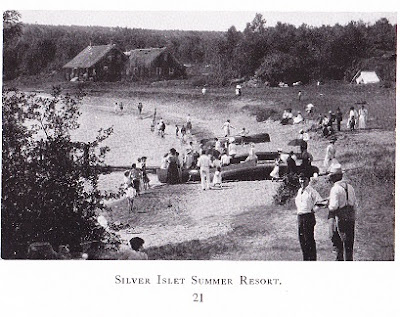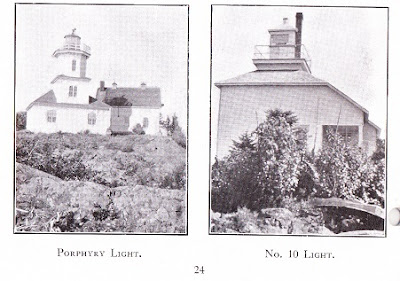NIPIGON - THE SEA WITHOUT A SHORE
By Madge Macbeth circa 1924
Nipigon Historical Museum Archives
part one:
NIPIGON! It is difficult to find the inevitable adjective that will conjure up the enchantment of that remote region and give to the prospective traveller even a filmy idea of the delight that may be his.
If he is a fisherman, he knows something of the country, by reputation anyway, for Nipigon is almost synonymous with "big trout," the size and sportiness of the red-speckled species having earned for it the respect of anglers the world over, and to say that one has fished the Nipigon waters covers just about all there is to be said.
The sporting opportunities of the Nipigon have been brought well within the grasp of vacationers, by the establishment of a Bungalow Camp on the southern shore of Lake Helen. The Canadian Pacific also erected a station especially for the convenience of its guests who have no need to disembark in Nipigon Village, about two miles distant from the Bungalows. A motor service operates over the few hundred yards between Camp and the new depot.
Nipigon is easily accessible to any point on the continent. It lies on the main line of the Canadian Pacific transcontinental service, nearly a thousand miles west of Montreal and seven hundred and forty-three miles northwest of Toronto, Port Arthur is only sixty-fives miles distant , while Winnipeg is about a days journey.
(2013 update - no passenger rail service on this Nipigon mainline anymore - VIA takes the passengers on the northern route north of Lake Nipigon.)
The Bungalow Camp, like those operated at French River and Kenora, provides urban conveniences plus the freedom and informality o the wilds.
A cluster of charming one - and two-room rustic bungalows surrounds a central or Community building, which contains the offices, dining and recreation hall. A spacious, screened verandah surrounds three sides of this Club House, wooing the gay breezes that a cavernous stone fireplace, within, succeeds in discouraging. This fireplace, by the way, is especially interesting by reason of the fact that the stone with which it is built contains great pieces of native amethyst. There is an amethyst "mine" quite near the Camp, where the visitor can secure any number of beautiful souvenirs.
Each cabin is a self contained rustic palace, with hardwood floors, chintz decorations, electric light, running water and comfortable beds. It also boasts of a clothes closet and is effectively screened. As the season advances and the soothing zephyrs of summer are absorbed in the chill rush of the north wind, stoves are added to the furnishing, and no greater cosiness can be found than in one's cabin with a brisk fire crackling and a pot of coffee breathing its fragrance through the room.
In justice to the prospective guest, however, it should be said right here that Nipigon Camp is no place for persons whose wish is to reduce. In atmosphere that fairly pricks the appetite, and with a cuisine that is beyond criticism, especially in the matter of fresh fish - well, the pounds do accumulate, despite energetic bathing in the sparkling waters of the lake, and other forms of vigorous exercise. There is an excellent beach at Nipigon sloping by easy gradations fifty yards or more to the end of a fine dock where more adventurous swimmers can enjoy the thrill of a diving board.
Dancing, of course, is one of the most popular pastimes, and frequently a good orchestra supplements the Camp piano and victrola.
However, the majority of guests do not go to Nipigon to dance, enjoyable as they may find this form of entertainment. They go to fish - to try to break the world record made in 1915, when a speckled trout weighing fourteen and one-half pounds was taken from its waters. Although failure has so far crowned their efforts, they are by no means dissatisfied, for five-pounders are common, and lake trout, pike and pickerel will reward the determined angler.
HISTORY AND INDI-ANA
If history wearies you, be good enough to turn the page. Upon the past is the present builded, and in the Nipigon country one finds a firmer footing on the foundation than upon its more modern superstructure.
True, Nipigon has acquired telegraph, telephone and railways; over it drift echoes of vast operations at Jackfish and Lake Superior; the electric plant at Hydro commands millions of gallons of its water which are transmuted into light, and flung out to cities miles away. But Nipigon does not feel like telephones and telegraphs, railways and steamboats and electric light. It feels like soft voices speaking in strange tongues, like pictures painted on rock or tree, like canoes guided by a strong brown hand, and torches cut from some resinous sapling. And passing but a few miles up the river, that is just about what one will find.
Authorities tell us that Nipigon was known to white people as early as 1612. De la Verendrye was one of the first famous explorers in the district. Brule, whose discoveries deserve more credit than is generally accorded them, certainly must have penetrated this region, and it is more than probable that Long made trips into the Nipigon, for he spent twenty years among the Indians, becoming not only a woodsman, and a fur-trader, but virtually on the savages themselves. He adopted their dress and customs, even to scalping his prisoners. He was admitted into the Chippewa (or Ojibway) nation as one of the most famous Chiefs of the day, and to attain such honour, he was obliged to undergo a very painful initiation. An account of the ceremony makes extremely interesting reading.
The vast territory north of Lake Superior, and fringing the shores of the Nipigon River to the lake of the same name, is one of the sections that has resisted civilization and the invasion of the white man. it is scantily settled, and at that, by the picturesque Ojibways who have occupied that territory since time immemorial.
They are a forest people, and although one of the largest tribes north of Mexico, strong in numbers and occupying extensive lands, they have never been prominent in history. The reason for this is that the Ojibways were always remote from the scene of warfare, particularly during the period of the Colonial struggles. According to tradition, they are part of an Algonquin body that separated into divisions when it reached Mackinaw in the westward movement.
Ojibway is a combination of
ojib, to pucker, and
ub-way, to roast, the significance being the manner in which this tribe pleated or puckered the lower part of their moccasins on to the piece that forms the top. In Long's account of them, he says they term themselves N'unawesik, meaning Natural Language, and implying that they speak the original tongue, while other tribes have an acquired one.
Referring to the "original tongue", Carver observes that it is easy to pronounce and more copious than any other Indian language. At the same time , it is not encumbered with any unnecessary tones or accents; neither are there any words that are superfluous. Being a stranger to ceremony or compliment, the Ojibways have no need for an infinity of words wherewith to embellish their intercourse.
In the matter of compliment, I am in perfect accord with Carver's observation. I found the guides a most disconcertingly frank people. One day, in a effort to familiarize myself with a few of the commoner terms, such as the numerals, the names of bird and beast and tree, I enquired of Chief Guide Nicholas John what the Indians called women.
"Queer," he answered, promptly, and with utter seriousness.
The hopeful member of the party suggested that he must have given me an Ojibway word that sounded like the uncomplimentary on above. I should like to believe it , but...
A two hour trip from Nipigon Camp will give the visitor a splendid view of the historic Picture Rocks on Lake Superior. This painting executed in colours that are foreign to any natural deposit in the vicinity, of a durability unknown to modern pigment and on rocks that hang, sheer, from immense heights to the water's edge, has always been a mystery to white people. But the Indians explain it with confidence. A Manitou, they say, placed his message there - a Manitou who had no need for colouring matter. He merely laid his finger upon the rock and his words became visible that all might read them, and for all time.
Nipigon added an interesting page to its history when the Prince of Wales visited the district and spent ten days fishing the sparkling waters of the river. Our party followed the route he had taken, and engaged the services of the same cook, as well as two or three of the same guides. They spoke of him in terms of affectionate respect, and were unanimous in according him the title of Ho-go-mar, or Big Chief.
TO BE CONTINUED






























